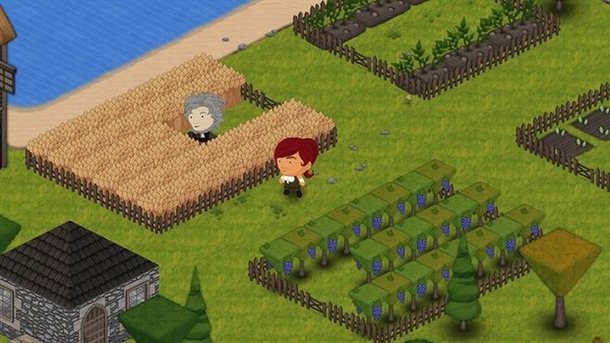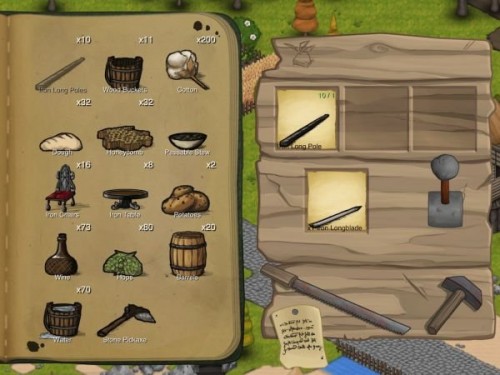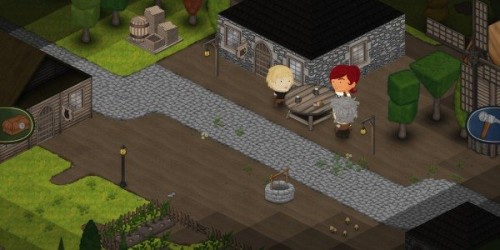
Naming your latest iOS title TownCraft is a bold move, but it’s a move fully embraced by Australian-based developer Flat Earth Games. In the wake of Marcus Perrson’s Minecraft, it’s perhaps not surprising to see others try their hand at the indie sandbox genre that has proven to be so wildly successful. The trouble for Flat Earth, though, is replicating a similar experience without critics openly dismissing the product as a poorMinecraft imitation before it’s even out of the gate. Indeed, I had my own scepticism when I happened upon the name, but I can thankfully confirm that TownCraft is a wonderful experience that stands on its own merits.
TownCraft puts you in the shoes of a lone medieval villager tasked with building up a township from scratch. The game generally provides a singular goal to aim for, such as preparing enough food for the region’s royalty, but TownCraft‘s key appeal lies in creating a bustling and vibrant town using the natural materials around you. Starting with nothing more than a handful of sticks and rocks, players must scavenge the environment for various resources which, when combined or reworked with other valuables, create more effective tools and components to aid in your endeavours.
What follows is a particularly addictive gameplay loop; every task is essentially a series of miniature check-lists whereupon completing those check-lists opens up new options. Even something as simple as baking bread, for example, is a highly involved process. First you must harvest some wheat, then grind it at a mill to make flour, then combine it with water to make dough, and then bake it in an oven you’ve built out of stone. Did I mention that to get the water for your dough you must first build a well and bucket comprised of iron bindings and round wood-cuts?
No doubt it sounds tedious on paper, but what prevents TownCraft from falling into a grinding monotony is that every resource you find has a practical use that can easily be applied with a simple but effective touch-and-drag crafting system. In fact, half the fun is gained from continuously experimenting with the resources you have stocked-pile to form recipes – there are 146 to learn in total – which are then conveniently listed in a sub-menu for future reference.
In addition to your own exploits, you can trade with or hire wandering NPC’s to assist you with your town’s tasks, such as woodcutting, farming, or operating the local tavern. Hiring others will cost a daily wage but can dramatically speed up proceedings and help your town grow. Achieve a high enough status and you will even start to attract more noble visitors to your pastures. Some NPC’s will also provide quests which serve as an additional source of revenue, though these are usually limited in variation and generally not worth the time; NPC’s wander in and out of the map, giving the player no reliable means of tracking them.
Indeed, as addictive as TownCraft is, it’s not without its faults. Hirelings often become stuck or remain stationary in the environment, requiring you to rehire them at additional cost. Farmers, in particular, manage to trap themselves between dead crops that can only be removed by the player. In addition, I thought it odd that the game sometimes disallowed seemingly reusable items; I had to craft a new bucket, for example, every time I needed more water or sand. It’s a minor complaint, assuredly, but one that eventually added up over time.
While on the subject of crafting, I appreciated the depth behind the system and the fact that, outside of a few small hints, the game encourages the player to make discoveries on their own. However, it would have been nice if a few liberties were taken with some of the more complex, late-game structures. Not knowing how to build many of these items essentially ground my construction efforts to a halt and restricted me from creating anything new: one of TownCraft‘s main draws. There’s also some fiddly path-finding and item placement issues which rear their head on occasion, though I suspect these will be ironed out relatively easily in future patches.
Overall, one’s experience with TownCraft is largely dependent upon what one wishes to gain from it. Whereas you could solely focus on reaching the end goal of your selected map, I found my primary satisfaction was derived from knowing I’d built something special out of nothing. Likewise, the absence of any dangers (contrary to those experienced in Minecraft) means you’re able to build and craft to your heart’s content, while a lengthy list of recipes provides enthusiasts with many hour’s worth of value in trying to discover them all. In truth, I question whether TownCraft‘s name does itself a disservice; sure it’s of the same vein asMinecraft, but it succeeds in carving its own identity and brand of enticing gameplay, and that’s all that matters.
Simple and easy-to-learn crafting system which yields plenty of depth | Satisfying gameplay loop encourages discovery
Some notable AI issues, particularly with farming | Determining late-game recipes can be a lengthy time investment






